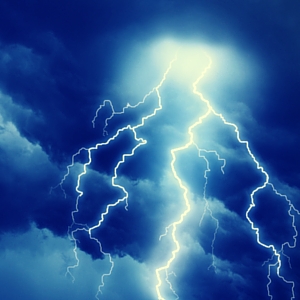Lightning Round: Test Your Knowledge

Most of us were taught to have the sense to come in out of the rain, presumably to avoid getting soaked. However, a far better reason is to avoid getting struck by lightning. Here are a couple of eye-opening statistics about lightning:
- According to the National Oceanic Atmospheric Administration (NOAA) on average, 28 people are killed each year by lightning strikes.
- The NOAA reports that lightning strikes are fatal in about 10% of those who are struck. The remaining 90% who survive often suffer from long-term, sometimes debilitating symptoms.
Now that we have you thinking about lightning, why not test your knowledge about with this quiz? After all, while the odds of getting struck by lightning are fairly low, it can never hurt to separate fact from fiction—and there are a lot of misconceptions out there.
Questions:
True or False:
- Lightning doesn't strike the same place twice.
- The safest phone to use during a storm is a corded phone.
- If someone has been struck by lightning and you touch them, you'll be electrocuted.
- It's safe to seek shelter under a tree during a thunderstorm.
- It's safe to take a shower during a thunderstorm.
- If there are no clouds or rain, it's safe to be outside.
- If you are stuck outside during a storm, it's best to lay flat.
Answers:
- False. Lightning can, and does, strike the same place twice—particularly tall, pointed, isolated objects. Case in point: The Empire State Building, which has been known to be hit by lightning up to 25 times a year.
- False. It's safe to use a cordless phone or a cell phone, but if lightning strikes a telephone line, it can send an electrical surge through the wires and to the handset—or anything plugged into an outlet. If the handset is not connected to an outlet, however, it is safe to use. Cell phones that are not attached to a charger are also safe to use.
- False. The human body doesn't store electricity; therefore someone who has been struck by lightning is not electrified.
- False. If lightning strikes a tree, the ground charge will spread out from the tree in all directions.
- False. Believe it or not, lightning can travel through plumbing, so it's best if you avoid showering, bathing, doing laundry (see #2) or washing dishes during a storm.
- False. If you hear thunder, you are at risk. Lightning can strike even when it's 10 miles away. Remember, when thunder roars, go indoors!
- False. Since the current can travel through the ground, lying flat can increase your odds of being electrocuted. It's better to curl up in a ball if you can't find a safe place indoors.
How did you do? If you are surprised at what you didn't know, now is a good time to do a little research on lightning.
Even if you aced the quiz, you should still be careful inside your home during a thunderstorm. Lightning has been known to strike houses, which can cause a fire, power surge damage to anything that was plugged in at the time and send shock waves that can cause concrete, brick and stone to crack. In extreme cases, it can shatter glass and blow out walls. Talk to a Shelter agent to find out how our homeowners insurance may be able to help if this happens to you.
